Following on from her webinar, our Digital PR Manager Joanna takes you through the dos and don’ts of starting an SEO outreach strategy.
Last time, we explored what Digital PR is and why it’s so necessary for your law firm. In this article, we’ll be taking a deeper dive into SEO outreach as a subset of Digital PR.
We’ll take a little look at the history of link building, and what makes it different from traditional brand-building tactics. We’ll then discuss how you can go about getting it right through taking you through the dos and don’ts of the process. Take a look…
What is SEO Outreach?
Every site has a Domain Rating (DR) or Domain Authority (DA); a metric determining site authority. On-site SEO is, of course, important to ensure people arrive at your site through search engines. That said, the only way to ensure people arrive on your site regularly is by increasing your DR.
The only way to increase this metric is through obtaining backlinks. These are a reference to your website on someone else’s site which has been hyperlinked. The link could come in various forms, whether it be a naked URL (www.conscious.co.uk), a branded anchor link (Conscious Solutions), or a keyword link (SEO for law firms). These then direct viewers to your website if they click on said hyperlink.
SEO Outreach vs. Traditional PR
SEO outreach is a specific offset of Digital PR, and it’s important to note that it is very different to the more traditional PR approach.
PR is based around brand exposure; you might set up a campaign with the aim to retrieve organic links to your site. With this, you’re building an image for your brand through other sites, with the aim to get clicks and conversions.
On the flip side, the purpose of SEO outreach is never about hoping for people to click on the link. Instead, it’s all about placing a link naturally on a good quality site to obtain some of their authority or “link juice”.
A link-building strategy, like this, will lead you to eventually rank higher for relevant search terms on Google so more relevant people will visit your site.
Why is SEO Outreach Important for Your Law Firm Website?
We touched upon this question in our previous blog post, which you can find here. Essentially, though, SEO outreach is important because it grows your DR, thus helping you to rank regularly for relevant search times so people find you when they need you.
According to several experts in the field, links are one of the top two criteria considered in Google's page ranking algorithm, alongside content. Ahrefs even go as far as to say they are the most important ranking factor, as they “form the basis of Pagerank, which is the foundation of Google’s ranking algorithm.”
This just goes to show they are a long-lasting element of SEO, and they’re here to stay. After all, linking to someone’s site demonstrates that their content is worth reading, so it makes total sense that it’s part of the algorithm.
The SEO Outreach Process at Conscious Solutions
There are various ways to go about SEO outreach but, at Conscious, we use the guest post method. This requires us to reach out to blogs and news sites for guest posts containing client links, which we then write.
This method ensures we have control over the site linking to the target page, the anchor keyword, and the content the link sits in (we’ll go into this terminology a little more later on).
The process of achieving this requires various steps. These are:
- Choosing a target page
- Finding sites to guest post on
- Vetting these sites for quality
- Reaching out to these sites
- Writing the guest post content
So, how can you go about each step of this process?
The Dos and Don’ts of Choosing a Target Page
The first thing you’ll need to do before anything else, is decide which landing page on your site you want to target.
You DON’T want to focus your efforts on services and keywords or phrases that you don’t want to rank for right now. You also DON’T want to focus on pages that you already rank first place for.
Instead, DO focus your efforts on pages that aren’t doing so well. If you do a monthly site audit and a ranking report, this will show you where you could be doing better.
Once you’ve decided which page you really want to focus on increasing traffic to, you must ensure the page ticks the following boxes:
- Is well-written and search engine optimised.
- Is informative.
- The content and article keywords fit the user intent, i.e. will attract people looking to make a claim.
Once this is done, you should then choose what keywords you want to rank for based on your defined user intent.
For example, say you have a medical negligence claim landing page. You want to target people who are looking to make a claim against their health service, so you’ll want to rank for certain search terms that gain these visitors, such as “medical negligence claims”, “medical negligence claims solicitors”, “medical negligence solicitor” and so on.
Think about what people are going to naturally and logically search for, and use a keyword software, like ahrefs or Google Keywords, to hone in on which keywords are worth ranking for based on monthly traffic. You can then use these terms as your “anchor text” to house your link in any published guest posts.
The Dos and Don’ts of Finding Sites to Guest Post On
Once you’ve decided on which page and keyword to target, you’ll need to find sites to guest post on. To do this, you must ensure the following:
DO Prioritise Relevancy
Firstly, any site you reach out to must be relevant to both your anchor keyword and your target page.
For example, with our medical negligence example again, your main focus should be on finding health sites to post on. So, research terms in Google, for example “health blogs list”, or hone it down to more specific search terms like:
- “write for us” + “health”
- “guest post” + “health”
- “health” + “blog”
Variations of the above should provide you with a huge number of sites to target.
That said, depending on your topic title, you don’t always have to stick to health sites for a medical negligence anchor keyword. You could even branch out to several different site themes, for example parenting sites, tech sites, or business sites.
A good example of where this might apply could be if you target a tech site for a medical negligence anchor keyword, and write an article entitled something like “What Does the Future of Technology Look Like in the World of Healthcare?”.
Another example could be if your anchor keyword surrounds Cerebral Palsy claims, you could target a sport and fitness site and provide them with a guest post about how running can help with Cerebral Palsy symptoms.
You can be quite crafty with it, as long as it’s as natural as possible, and you’re not stretching the limits of a topic too far.
DO Ensure the Site DR is Higher Than Your Own
Secondly, you must make sure that the DR of the site you are considering guest posting on is higher than your own. You can view this using a software like ahrefs or Moz. We use the ahrefs site explorer for this:

As you can see, the Conscious website has a DR of 61, meaning anyone with a DR below this number would benefit from a link from Conscious’ site.
The only exception to this rule is if you’re getting a backlink from a local site to you. For example, say your law firm is based in Newport and you find a site with a very low DR in South Wales, but you think the site is relevant to your keyword. Guest posting here, and obtaining a link, will have a huge amount of value even if their DR is lower than yours.
To search for sites within your locality, you can use similar search terms to the ones above, replacing “health” with “your location”. To be even more specific, however, you can even replace these terms with a postcode near you, for example, “BS7”.
DON’T Use the Same Site More than Once
It’s very important to note that there is no added SEO value in getting a link from the same site twice or sites that have the same IP address. Of course, if you can get a link from a site like the BBC more than once, this is great for PR brand image. However, as we’ve discussed, this is more PR, and if you’re implementing a link-building strategy as part of your SEO plan, you should target different sites each time.
DON’T Take Sites Offering No-Follow Links
Finally, you should only focus your efforts on sites that will take do-follow links. These are links that are crawled by Google, which is much more valuable than the alternative no-follow.
Although no-follow links do have some value in terms of being clicked on, they don’t have the same SEO value as do-follows, so always try to request these if you can. You can request this when you reach out to the site administrator, and they will be able to factor this into their site HTML code.
The Dos and Don’ts of Vetting Sites
Now that we’ve decided on sites to target, it’s time to vet them for quality. You can’t just pick any old site, as they’re not always as they seem. To do this, you will need a software to analyse a site’s metrics, like ahrefs, and will need to consider the following:
DO Consider Various Metrics, Not Just DR
Although Domain Rating is important, the only way to increase DR is through backlinks. Because of this, DR alone is not indicative of authority, as it is possible to pay for spammy backlinks in some of the ways we’ve discussed previously.
To ensure a site is of good quality, we must also take a closer look at several other metrics, including:
- Referring domains graph: DO use sites that have a steady or gradually increasing referring domains graph.
- Organic search graph: same as the above with the organic search graph.
- Organic keywords: DON’T use sites that rank for dodgy or irrelevant keywords.
- Backlinks: DON’T use sites that have lots of spammy backlinks, for example completely irrelevant backlinks.
- Referring domains: DO use sites that have links from good referring domains that you recognise, like big media sites.
Ultimately, we’re looking for sites that rank organically for keywords so have, therefore, been linked to naturally. This can be demonstrated in their backlink profile, which shows that their high DR is deserved.
DO Ensure the Site Itself is Good Quality
That’s not all though, as you also need to ensure that a site is of good quality when you enter it. This can be judged via:
- The quality of their written content – is it long, well-written and informative?
- Is the site user friendly and easily navigable?
- Does the site have minimal ads to ensure the reader’s experience isn’t interrupted?
If a site manages to tick all these boxes, you can almost guarantee it’ll be a good one to use for a guest post.
The Dos and Don’ts of Reaching Out to Sites for a Guest Post
Now we have a list of sites to reach out to, it’s time to bite the bullet and reach out to them.
To do this, you need to first make sure you keep track of the pipeline of your contacts, especially if you’re doing this on a large scale. After all, as we’ve discussed previously, you need to make sure you’re not guest posting on the same site twice.
DO Keep Track of Pipeline of Contacts
We use a software called Airtable for this, but you can use an Airtable alternative too. Here, we firstly have a master contact database where we store all the sites our team have found so far. We fill out the contact details and site theme etc. and whether they’re good to use once they’ve been vetted, like so:
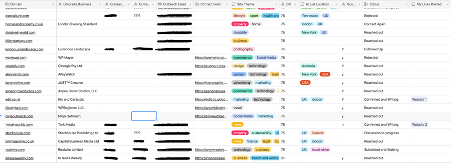
It’s then important to keep track of the status of these contacts. For this, we use an outreach log that is linked to the master contact list via the “status” field. This is important so that you can create an effective reach out and follow up campaign.
DO Keep Track of the Guest Posts You’ve Published So Far
It’s then also important to keep track of the myriad of articles you’ve had published through outreach. We keep track of this on the Links Posted tab, which links to our master contact database, meaning we can filter out sites that have been used already when we want to reach out.
![]()
This helps us to avoid getting guest posting on the same site more than once.
DO Make Use of Tab Linking to Allow for Effective Filtering
The master list should house every site you’ve ever canvassed and vetted. Then, we’d suggest whatever app you use has a filter option, which will come in handy when you’re targeting sites in specific situations.
For example, say you’re looking to get a guest post published for Website 1. You want to pitch a tech-related medical article to a site that’s been vetted and is good to use, that you’ve never reached out to before, and that has a DR 40 or above. In this case, you’ll want to set your filters like so:
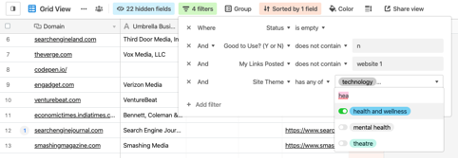
Then, you could order the sites by DR to isolate any site above a DR 40 to target these. This way, you can tick off all the requirements before reaching out, as well as avoid wasting time reaching out to sites you’ve previously used.
The Dos and Don’ts of Reaching Out
Now it’s time to start writing your emails. The first step for this is to personalise them. DON’T simply send out generic mail merge emails that are clearly automated. Take the time to visit each site and pinpoint something you like about their site.
Once you’ve done this, you then need to get straight to the point – who are you, and what do you want? Within this, you should pitch them an actual idea, or a number of ideas, to give them a taste of what you offer.
DON’T Send Emails Like This
Some examples of poor emails we’ve received in the past include:
Example 1:
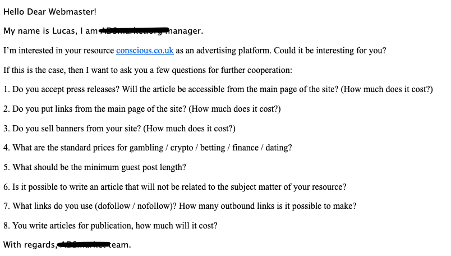
Example 2:

As you can see, the above examples have no personalisation – they don’t even say “Hi Joanna”, despite the fact that this information would have been freely available on our website. It’s pretty clear, from this alone, that they aren’t targeting us personally, but are sending out a generic email, potentially to a mailing list.
On top of this, they haven’t shown any interest in our site; they haven’t mentioned why we would be a good match for them, and why we should consider their guest post. We’ve received no potential pitches or explanations, so there’s nothing to warrant our interest.
DO Send Emails Like This
Alternatively, we would look to send an email more along the lines of this:
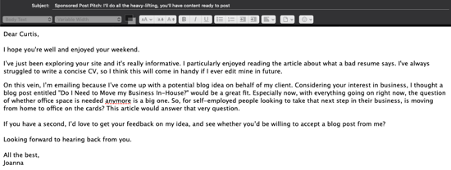
Here, we’ve provided the following incentives to reply:
- An engaging subject line.
- A first name.
- We’ve told them something we love about their site, so we’ve clearly taken the time to peruse it.
- A pitch idea.
- An explanation of what the article would discuss.
- We’ve been polite and friendly.
Can We Personalise Without Sending Individual Emails?
Although we DON’T want the email to appear mail-merged, there are ways you can reach out to people en masse whilst also staying personal. To do this, when you’re researching sites, you should make a note of the finer details of their site, for example their location or a particular niche.
Then, when creating your mail merge fields, you can include mail merge columns like “location” and “site topic” to personalise a lot of emails at once, like so:
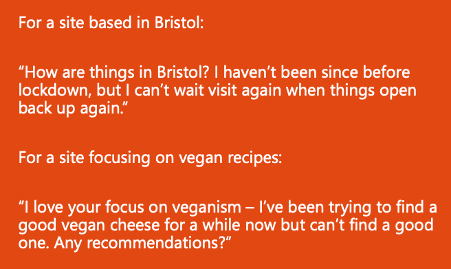
This way, you can quickly copy and paste the fields to the relevant contacts and create what can look like a very personalised mail-merge list, ready to import into Mailchimp, or whatever tool you’re using.
The Dos and Don’ts of Writing Guest Post Content
So, you’ve chosen a target page and a guest post site, you’ve reached out to them and have now agreed on a title – it’s time to write. This is just as important as any other step, as it’s the whole reason we choose guest posting to build links above other ways. So, you must be sure you tick the following boxes:
- Make sure the article is well-written – this includes grammar, and relevant headings throughout.
- Ensure the article has a good word count. This depends on the topic, but a good ballpark figure is around 1000 words.
- Make sure the article fits in with others on the site, so if it’s a news site, try to make your article newsy, but if it’s a blog site, try to write it in the style of a blogger.
- Make sure your site link is high up within the article; ideally it should be the first link in the article, somewhere within the introduction of the blog.
- Ensure the link is added in naturally and seamlessly.
- Be sure to include other authoritative links to back up your claims throughout the text, i.e. BBC, healthline, NHS, pubmed.
For more information about writing SEO blogs that are well-written, here is a great article for just that.
Think You’ve Got What It Takes?
As you can see, there’s a huge amount of work that goes into an SEO outreach strategy. This article covers pretty much all the bases so you can consider giving it a go yourself.
Otherwise, at Conscious, we offer a fully-fledged outreach service that does all the hard work for you. If you want to see your site gain traction in organic search, don’t hesitate to put an SEO outreach strategy into place.

